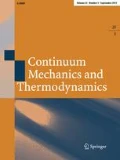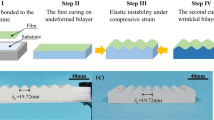Abstract
The interlayer stress and delamination failure mechanism of the multilayer membrane structure of microelectromechanical systems under thermal coupling condition are basic research topics in modern micro-optoelectronics. To address the deficiency of the classical plate membrane model in analyzing interlayer stress, this work proposed a more reasonable beam membrane model, deduced the thermo-induced curvature and interlayer shear stress equation of the two-layer system and analyzed the influences of heating power, film/base thickness ratio, and relaxation time. In addition, the finite element model established by Comsol Multiphysics is compared with the classical plate membrane model and beam membrane model. Numerical results showed that the curvatures of the traditional polymer and hybrid structures increased with power, and that the value of the beam membrane model was greater than that of the plate membrane model. The curvature of the hybrid structure increased with film thickness. When the thickness ratio was 0.5, the curvature of the traditional polymer structure reached its maximum value. The finite element results are consistent with the beam membrane model, indicating that the beam membrane model has higher accuracy. When film relaxation time increased to the order of \(10^{-3}\,\hbox {s}\) magnitude, the thermal mismatch stress and curvature of the two structures increased considerably. Shear force increased exponentially with distance from the center of the interface and reached its maximum value at the interface end. These results can provide references for the safety design of optical switches.








Similar content being viewed by others
References
Meng, J.: Optimal Design and Fabrication of the Polymer Planar Waveguide Optical Switches. Jilin University, Changchun (2012)
Xie, J., Konvopoulos, K.: Friction, nanostructure and residual stress of single-layer and multi-layer amorphous carbon films deposited by radio-frequency sputtering. J. Mater. Res. 1(13), 1–8 (2016)
Chen, Y., Qiao, P.Z., Jiang, H.D.: Review on experimental methods and fracture models for bi-material interfaces. Adv. Mech. 38(1), 53–61 (2008). (in Chinese)
Liu, J.: Micron/Nanometer Scale Heat Transfer. Science Press, Beijing (2006)
Tamma, K.K., Zhou, X.M.: Macroscale and microscale thermal transport and thermo-mechanical interactions: some noteworthy perspectives. J. Therm. Stresses 21, 405–449 (1998)
Wang, L., Bai, R.X., Yan, C.: Interfacial debonding behavior of composite beam/plates with PZT patch. Compos. Struct. 92(6), 1410–1415 (2010)
Vengallatore, S.: Analysis of thermoelastic damping in laminated composite micromechanical beam resonators. J. Micromech. Microeng. 15(12), 2398–2404 (2005)
Groverd, J.S.: Thermoelastic vibration analysis of Mems/Nems plate resonators with voids. Acta. Mech. 233(1), 167–187 (2012)
Zhang, L., Zhang, X.M., Song, J.Y., et al.: Generalized thermoelastic analysis of thermo-optic switch multilayer structure. Optik 178, 432–438 (2019)
Liu, J.K.: Thermal stress analysis on multilayer structure. Chin. J. Sens. Actuators 29(7), 994–999 (2016). (in Chinese)
Suhir, E.: An approximate analysis of stresses in multilayered elastic thin films. J. Appl. Mech. 55, 143–148 (1988)
Suhir, E.: Interfacial stresses in biometal thermostats. J. Appl. Mech. 56, 596–600 (1989)
Suhir, E.: Predicted thermally induced stresses in, and the bow of, a circular substrate/thin-film structure. J. Appl. Mech. 88(5), 2363–2371 (2000)
Freund, L.B., Suresh, S.: Thin Film Materials: Stress, Defect Formation, and Surface Evolution. Cambridge University Press, Cambridge (2003)
Lord, H.W., Shulman, Y.: Ageneralized dynamical theory of thermoelasticity. J. Mech. Phys. Solids 15(5), 299–309 (1967)
Liu, J.K.: Thermal stress analysis on multilayer structure of MEMS. Electron. Comput. Mater. 34(9), 71–74 (2015). (in Chinese)
Acknowledgements
This work was supported by the National Natural Science Foundation of China (No. 11602042), Chongqing Research Program of Basic Research and Frontier Technology (No. cstc2018jcyjAX0514) and Research Foundation of Chongqing University of Science and Technology (ck2017zkyb020).
Author information
Authors and Affiliations
Corresponding author
Additional information
Communicated by Andreas Öchsner.
Publisher's Note
Springer Nature remains neutral with regard to jurisdictional claims in published maps and institutional affiliations.
Rights and permissions
About this article
Cite this article
Zhang, L., Zhang, X., Song, J. et al. Thermo-induced curvature and interlayer shear stress analysis of MEMS double-layer structure. Continuum Mech. Thermodyn. 32, 1127–1139 (2020). https://doi.org/10.1007/s00161-019-00816-9
Received:
Accepted:
Published:
Issue Date:
DOI: https://doi.org/10.1007/s00161-019-00816-9




